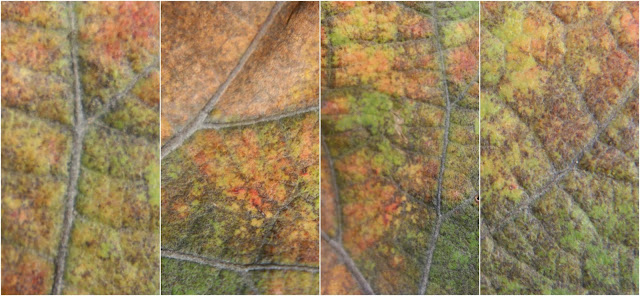This week has been all about leaves. Autumn leaves provide a valuable source of organic matter that can be used in our landscapes in many ways. The ESC volunteers have been helping the Mayor to clear the leaves from the streets and taking some of them back to the crew house garden where they are being used to build the soil. We're going to look at three different ways to use leaves in the garden to help create healthier soils. But first, let's look briefly at the science behind the colours of autumn.
Leaves get their green colour from their photosynthetic cells, chloroplasts, that contain light-absorbing pigments. These pigments respond to different wavelengths of light. You are probably familiar with the main pigment used to help plants photosynthesize - Chlorophyll - but Chlorophyll is also assisted by the pigments Carotene and Xanthophyll. Carotene is responsible for the orange colour of the carrot while 'Xantho' is Greek for yellow. These two pigments are always present in leaves, unlike Chlorophyll which stops being produced in a response to the shortening days. It's commonly thought that leaves get their green colour in the growing season due to Chlorophyll reflecting green light, but regardless of where the actual reflective action goes on, it is clear that with Chlorophyll not being produced, the orange and yellow pigments of the Carotine and Xanthophyll become visible. The red hues that we see come from pigments called anthocyanins, which actually not all trees produce. There are many theories as to the role of anthocyanins, the most widely accepted being that they protect the leaves from excess sunlight and help the trees to recover any last remaining nutrients before shutting down. In addition to the processes described above, trees also form a separation layer of cells at the bottom of each leaf to seal it from the tree. Once the layer is complete the leaf falls. This entire process is known as senescence and can be seen as a coded or programmed shut down before the death of the actual cell.
It's not essential for a grower to understand plant physiology and the scientific basis of how everything is working but it does also seem an inevitability. The book that we recommend delivered this knowledge in a way that only someone who has dedicated their life to trying to understand the complexity of plants and plant care can - the brilliant Botany for Gardeners by Brian Capon.
1. Leaf Mold
 |
| Leaves piled up and not mixed with other organic matter for leaf mold |
2. Compost
3. Mulch
 |
| Pyrus spp. - Pear leaf mulch on a bed of Garlic planted in October |
Regenerative Landscape Design - Online Interactive Course
Want to learn how to design, build and manage regenerative landscapes? Join us for our Regenerative Landscape Design - Online Interactive Course from May 1st to Sep 13th, 2023.
We're super excited about running the course and look forward to providing you with the confidence, inspiration, and opportunity to design, build and manage regenerative landscapes, gardens, and farms that produce food and other resources for humans while enhancing biodiversity.

Regenerative Landscape Design Online Course
You can find out all about the course here and right now we have a 20% discount on the full enrollment fees. Just use the promo code RLD2023 in the section of the registration form to receive your discount.
We are looking forward to providing you with this unique online learning experience - as far as we know, the very first of its kind. If you are thinking of reasons why you should do this course and whether this course is suitable for you, take a look here where we lay it all out. Looking forward to it!
We're super excited about running the course and look forward to providing you with the confidence, inspiration, and opportunity to design, build and manage regenerative landscapes, gardens, and farms that produce food and other resources for humans while enhancing biodiversity.
 |
| Regenerative Landscape Design Online Course |
You can find out all about the course here and right now we have a 20% discount on the full enrollment fees. Just use the promo code RLD2023 in the section of the registration form to receive your discount.
We are looking forward to providing you with this unique online learning experience - as far as we know, the very first of its kind. If you are thinking of reasons why you should do this course and whether this course is suitable for you, take a look here where we lay it all out. Looking forward to it!
--------------------------------------------------------------------------------------------------------------------------
Support Our Project
If you appreciate the work we are doing you can show your support in several ways.
- Make a purchase of plants or seeds from our Bionursery or Online Store
- Consider joining us for one of our Courses or Online Courses
- Comment, like, and share our content on social media.
- Donate directly via PayPal to balkanecologyproject@gmail.com or via FTX Pay
- Make a purchase of plants or seeds from our Bionursery or Online Store
- Consider joining us for one of our Courses or Online Courses
- Comment, like, and share our content on social media.
- Donate directly via PayPal to balkanecologyproject@gmail.com or via FTX Pay
References









No comments:
Post a Comment